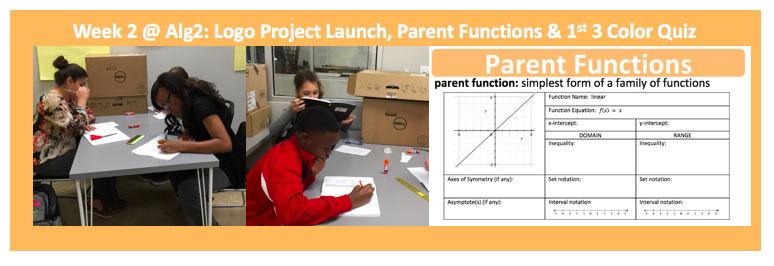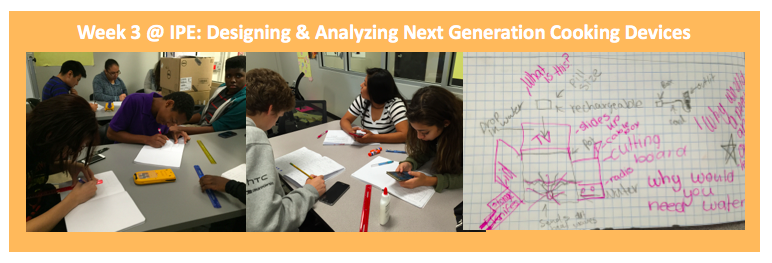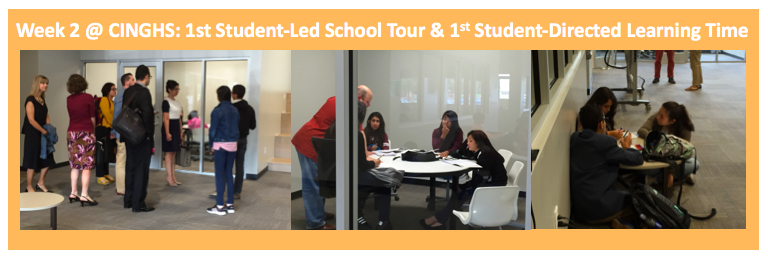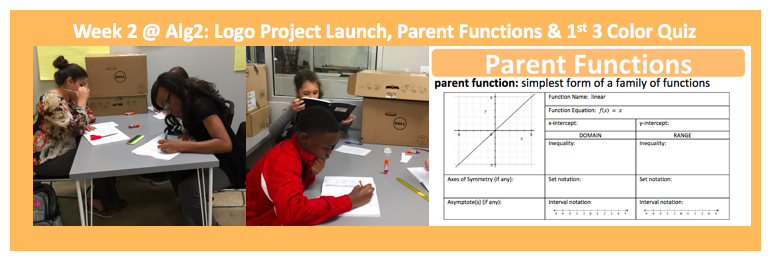Day 1 CINGHS Orientation
On the first day of school, all the students met their advisory teachers and rotated with their advisories through 5 orientation sessions:
- School Philosophy: Who are We and Why (led by Mrs. Garner and Ms. Thompson)
- School Culture (led by Mrs. Harden and Mr. Hammontree)
- Intro to Project Based Learning (led by Mr. Ray and Mr. Chambers)
- School wide Learning Outcomes (led by Ms. DiMaria and Dr. Trinidad)
- School Logistics (led by Mr. Fishman and Mr. Santos)
I co-facilitated the School wide Learning Outcomes session with Ms. DiMaria. We introduced the New Tech Network Learning Outcomes by playing games that represented each of the learning outcomes:
- Group Cup Stacking (Collaboration)
- Estimate the Jelly Beans (Knowledge & Thinking)
- Blind Drawing (Oral Communication)
- Group Paper on Growth Mindset Video (Agency and Written Communication)
I was impressed by all the students’ enthusiasm, team work, and critical thinking during the SWLO learning activities. I’m really glad the CINGHS staff collaborated to create a cohesive orientation that presented an overview of our whole school on Day 1. I believe it’s very helpful and important to present a unified school story and team from the start. Our first day was covered by the Austin American Statements in
this article.
Week 1: Integrated Physics and Engineering
For the opening week of Integrated Physics and Engineering, Mr. Fishman and I co-facilitated activities that enabled us to get to know our students, to introduce what is Physics and Engineering, and to give students a taste of the engineering design process.
On Tuesday, we started to learn student’s names and interests by playing 4 Corners. We then introduced ourselves to our students with the aid of slides covered with picture collages. We watched videos that described physics and engineering in general and used Mentimeter to gather student impressions on
Physics and
Engineering.
On Wednesday, we did a Carousel Brainstorming activity to guide students to brainstorm, create and refine norms based on our school’s Core Values: Integrity, Respect, Responsibility, Perseverance, and Trust. Several of the classes generated very detailed and helpful sets of classroom norms that rivaled the norms generated by our school’s staff members.
On Thursday, our students demonstrated what they know about gathering, organizing and using data by doing a Balloon Challenge activity. They gathered data on balloons wired to strings via straws. They used this data to predict how much they needed to blow up balloons to hit two targeted distances. I was impressed that many teams were able to hit 1 (and even 2) target distances during the 10-minute test time at the end of the period.
Also at the start of Thursday, Mr. Fishman and my students humored me while I trumped up the Class Norm Signing Process by playing Pomp and Circumstance while the students signed the norms and while the norms passed through the laminator to seal their agreements.
On Friday, we set up their notebooks and started a workshop introducing the Engineering Design Process. In this workshop, the students will learn all the steps of the design process we will apply throughout the year in several projects and will practice applying those steps to a sample scenario.
Week 1: 8th Grade Math
For the opening week of 8th grade math, Mr. Fishman and I co-facilitated activities from the Week of Inspirational Math series created by the YouCubed group at Stanford University led by Jo Boaler. The series of videos and activities are designed to cultivate growth mindset attitudes towards mathematics.
On Tuesday, we played ice breakers to get to learn our students’ name and interests. We did a How Many Dots activity and discussed how different people approach math from different angles. We also discussed examples of behaviors that are good and bad for effective math group work.
On Wednesday, we elected our 3 class officers. Then the students discussed, interpreted and created Emoji Graphs. The students seemed to really enjoy mapping out their interests on two-dimensional graphs. Also, our class officers quickly assumed their roles and started helping the class manage the time and materials more efficiently.
On Thursday, we helped the students set up their notebooks. The students also did a Carousel Brainstorming activity to brainstorm, create and refine their classroom norms based on the 5 Core Values.
On Friday, the students completed their first activity in their notebooks. They used drawings and mathematical reasoning to predict how a pattern of shapes was growing. I enjoyed doing this activity as a facilipant. At first I was pretty stumped and then one of the students shared a geometric insight that got my brain cooking and I was able to derive an equation that described the pattern growth for all cases. The students and I also enjoyed imitating how the actors in Jo Baoler’s growth mindset videos acted out brain synapses everytime someone in the class had a cool idea.
Week 1: Algebra 2
In the opening week of Algebra 2, I facilitated ice break activities and more activities from Jo Boaler’s Week of Inspirational Math series. These activities were similar to the 8th grade math activities in that they featured various aspects of growth mindset thinking and research and they were different because they were a little more advanced.
On Tuesday, we played a Ball Game to get to know each other’s names and preference. Then we watched and discussed a video on Growth Mindset. We formed teams and brainstorm Group Work Do’s and Don’t in teams. Then the teams practiced creativity and order of operations in math by trying to create the numbers 1 to 20 using algebraic expressions that featured the number 4 four times. The students asked for this activity to become a competition and they worked very intensely during the Four 4’s work time.
On Wednesday, we continued our Four 4’s competition by using expressions with Four 4’s to create the numbers -1, -2, … to -20. The teams with the most improved number of expressions (from the previous day) and the most expressions earned extra credit. After this activity, the students did a Carousel Brainstorming activity to brainstorm, create and refine their class norms based on the 5 Core Values.
On Thursday, we opened with a Class Norms signing ceremony. Then we elected our Classroom Officers. Only on person each nominated themselves to be the Facilitator and the Time Manager. Four students nominated themselves to be grade manager. Each gave a short speech on why they would be effective. For the first time in my history of working with class officers, there was a four way tie for the position. The Facilitator broke the tie with the help of the Time Manager by sitting in a spinning chair with his hand outstretched while the Time Manager gave him a few pushes. The nominee closest to his hand when the chair stopped spinning was chosen to be Grade Manager.
Also on Wednesday and Thursday, we practice using skepticism to spur deeper thinking by doing paper folding challenges in teams and then practicing explaining the challenge solutions to skeptics who responded to the explanations with a series of questions that challenged the students to explain their methods using more details and examples.
On Friday, the students set up their notebooks and they finished an activity on Emoji Graphs. They completed the activity with the same enthusiasm as the 8th grade math class. I was impressed by how they used internet research to verify that their relative positioning of their points (foods, phones, song lengths, etc) was accurate. We closed Friday with a gallery walk that got students to critically examine the Emoji Graphs created by other teams.










